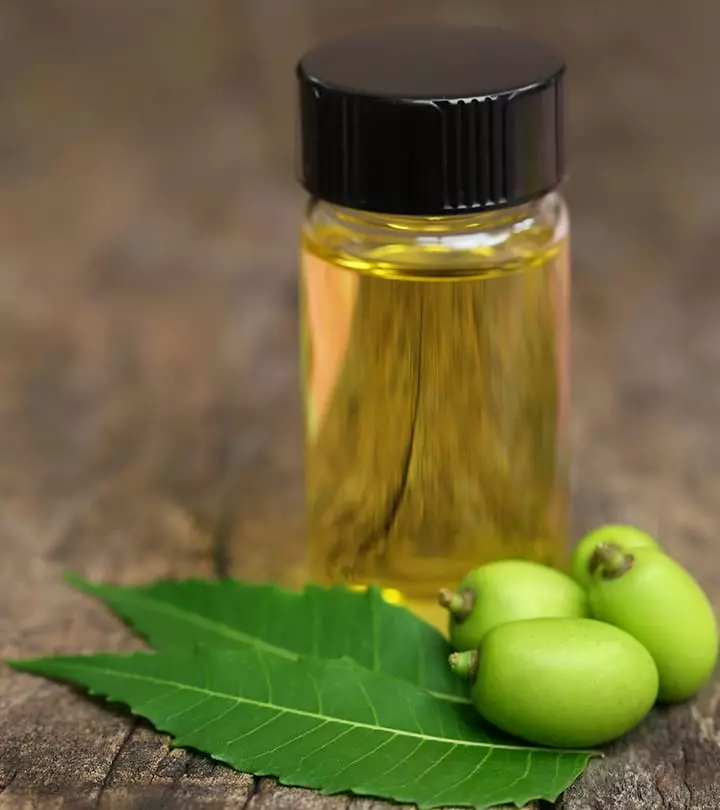What Is Stearic Acid? What Are Its Benefits For The Skin?
Have radiant, glowing skin with the goodness of this acid that protects your skin barrier.

Image: Shutterstock
What is stearic acid? Have you ever heard of it? If you look at the ingredients list of all your skin care products, odds are you will discover this ingredient in a majority of them. Stearic acid is included in practically every product, from bathing soaps to lotions and creams. It offers various skin benefits and functions as an emollienti A substance that helps moisturize the skin by forming a protective layer or barrier on the skin and trapping moisture. , surfactant, and emulsifier. If you are wondering what are the benefits of stearic acid for skin then scroll down to know more.
In This Article
What Is Stearic Acid?
Stearic acid is a long-chain saturated fatty acid, like oleic acid.
It is also known as octadecanoic acid and naturally occurs as a glycerol ester in plant and animal fats (1), (2).
Animal fat contains more stearic acid, palmitic acid, lauric acid, and myristic acid compared to vegetable fat. Animal fat contains 30% stearic acid, while it is less than 5% in vegetable fats. However, the only exceptions are cocoa butter and shea butter. These two plant oils contain 28%-45% of stearic acid (2).
 Did You Know?
Did You Know?Both shea and cocoa butters have a positive impact on skin health (3), (4). Let us take a look at the positive effects of stearic acid on the skin.
Key Takeaways
- Stearic acid helps improve the skin’s natural barrier function to help retain moisture and decrease water loss.
- It also reduces inflammation in skin conditions like atopic dermatitis, eczema, etc.
- Cocoa butter, shea butter, and animal fat are the rich sources of this emollient and natural cleanser.
- Stearic acid also aids in increasing the shelf life of products through its emulsifying properties.
What Are The Benefits Of Stearic Acid For The Skin?
Stearic acid is unlike other facial acids (the AHAs and BHA). It is mainly used in dermatological formulations in lotions and soap making, among other products, for the following reasons:
1. Improves Skin Smoothness


Stearic acid is an emollient and helps maintain and protect the skin’s natural barrier (5). Emollients keep the skin smooth by reducing transepidermal water lossi The amount of water that evaporates through the skin’s surface to the external environment or into the air. (TEWL) and maintaining moisture levels (6).
2. May Improve Skin Permeability
The role of emollients is not limited to skin smoothening. They offer therapeutic benefits by influencing skin physiology and pathology. Emollients impact the functions of the skin barrier and play an essential role in skin repair and permeability. They prepare your skin to absorb moisture and ingredients better (5). Stearic acid may also promote skin repair and improve skin texture.
3. May Relieve Skin Inflammation

Emollients can calm inflammatory skin conditions like atopic dermatitisi A chronic or long-term allergic, inflammatory skin condition that causes itchy, red, bumpy, and cracked skin. and eczema. These conditions compromise the skin’s barrier and may cause redness, dryness, cracked skin, and itchiness. Shea butter is rich in stearic acid and is an effective monotherapy for mild to moderate atopic dermatitis and other inflammatory conditions. It repairs the skin barrier and soothes inflammation (5).
4. May Cleanse The Skin
Stearic acid also works as a surfactant. It is commonly used in cleansers and soaps as it binds to oil, water, and dirt, making it easier to clean your skin. Moreover, this emollient does not strip the natural oils, thus providing gentle cleansing. If you have sensitive or compromised skin, you can use gentle cleansers with stearic acid.
 Trivia
Trivia5. May Help Manage Oily Skin
Stearic acid can manage oily skin due to its ability to function as an emollient, which helps to maintain the skin’s moisture balance and create a protective barrier (7). Its ability to control excessive oil production while preventing dehydration also makes it a good choice for oily skin. Skin care formulations often incorporate stearic acid to deliver a smooth, non-greasy texture to the products. Therefore, it is a preferred ingredient in moisturizers and cleansers for individuals with oily or acne-prone skin. However, as with any skin care product, individual responses may vary, so it is advisable to select products with stearic acid as part of a comprehensive skin care routine tailored to address your specific needs.
Stearic acid is used in different ways in skincare products and cosmetics. Let’s take a look at them.
How Stearic Acid Is Used In Skin Care Formulations
Stearic acid can be animal or plant-derived. It is primarily used in cleansing and body lotions, soaps, creams, ointments, and body oils as a:
1. Thickener

Without stearic acid, the soap bars you use cannot hold their shape. It works as a thickener to harden the product so that it can hold shape. Other than soap bars, stearic acid is also used in oil pastels and candles.
Marie, a YouTuber, shared her experience of preparing stearic acid formulations at home and using them on her skin, saying, “One way I like to think of it is that stearic acid can take a liquid oil and transform it into something that feels like a butter. You can blend stearic acid with other fatty thickeners like cetyl alcohol or cetearyl alcohol and waxes like beeswax or candelilla wax to get the best of everything.” There are many benefits of cetearyl alcohol for the skin. It acts as an emollient and helps in smoothing the skin, making it a perfect companion in formulations alongside stearic acid. She added, “I also love stearic acid for thickening up washed off-anhydrous products like cleansing balms because it rinses off the skin much more nicely and completely than waxes generally do (i).”
2. Surfactant

Stearic acid is a surfactant, and without this ingredient, the soaps, face washes, and cleansing gels cannot remove dirt and grime from your skin. It emulsifies oil and fat to suspend the impurities and dirt. As a result, it is easier to remove dirt from the skin.
3. Emulsifier
The skin creams that you use are generally emulsions of oil and water. If you are wondering how oil and water mix – stearic acid is the answer. It is an emulsifier that prevents oil and water from splitting and increases the longevity of the product. A common emulsifier is glyceryl stearate made by mixing glycerin and stearic acid.
Stearic acid has a hydrophilic (water-loving) head and hydrophobic (oil-loving) tail. These two ends attract water and oil and keep them together.
If you are concerned about the adverse effects of stearic acid and wondering whether it is suitable for your skin or not, take a look at the next section.
Side Effects Of Stearic Acid

Stearic acid is considered safe and non-toxic for the skin (1). Moreover, the formulations use trace amounts of the ingredient, which is usually safe for the skin. However, any ingredient can trigger allergic reactions and cause redness, itching, and mild irritation, especially for delicate or sensitive skin. It’s essential to monitor your skin closely and discontinue use in case of irritation.
Stearic acid has several benefits and functions as a surfactant, emollient, and emulsifier. It is used widely in skin care products because it helps maintain moisture levels, promotes skin repair, calms skin inflammation, and cleanses the skin. Though popular among skin care enthusiasts, many still do not know what stearic acid is. You can find this ingredient in skin care formulations like body oils, soaps, lotions, creams, and ointments. It is considered safe and non-toxic. However, you may do a patch test before using it as it may cause mild allergic reactions.
Frequently Asked Questions
Is stearic acid the same as citric acid?
No, there are a few differences between citric acid and stearic acid. Citrus acid is an odorless and colorless compound derived from citrus fruits. Stearic acid is a solid fatty chain acid derived from animal and plant fats.
Is coconut oil high in stearic acid?
Yes, coconut oil is one of the plant derivatives that is high in stearic acid (8).
Is stearic acid carcinogenic?
No. Instead, studies suggest that stearic acid may help in cancer cell death and stop the cell cycle (9).
Does stearic acid clog pores?
No, stearic acid is one of the skin care ingredients that does not clog pores and is ideal for all skin types.
Is stearic acid safe in vitamins?
Yes, magnesium stearate is the magnesium salt of stearic acid. Magnesium stearate is commonly used in food additives and vitamin supplements as a flowing agent. It is considered safe for use (10).
Is stearic acid good for vegans?
Yes, you can choose products that use stearic acid derived from plant-based sources.
Illustration: What Is Stearic Acid? What Are Its Benefits For The Skin?

Image: Stable Diffusion/StyleCraze Design Team
Explore the uses and potential risks of using stearic acid in this informative video. Learn about its applications and how it may impact your well-being.
Personal Experience: Source
StyleCraze's articles are interwoven with authentic personal narratives that provide depth and resonance to our content. Below are the sources of the personal accounts referenced in this article.
i. STEARIC ACID for skin care | 5 free formulas | Ingredient deep divehttps://www.youtube.com/watch?v=7QlC_c35t54
References
Articles on StyleCraze are backed by verified information from peer-reviewed and academic research papers, reputed organizations, research institutions, and medical associations to ensure accuracy and relevance. Read our editorial policy to learn more.
- Stearic Acid
https://pubchem.ncbi.nlm.nih.gov/compound/Stearic-acid - Octadecanoic Acid
https://www.sciencedirect.com/topics/chemistry/octadecanoic-acid - Cocoa Bioactive Compounds: Significance and Potential for the Maintenance of Skin Health
https://www.ncbi.nlm.nih.gov/pmc/articles/PMC4145303/ - Shea Butter
https://www.sciencedirect.com/topics/agricultural-and-biological-sciences/shea-butter - The Role of Moisturizers in Addressing Various Kinds of Dermatitis: A Review
https://www.ncbi.nlm.nih.gov/pmc/articles/PMC5849435/ - Role of topical emollients and moisturizers in the treatment of dry skin barrier disorders
https://pubmed.ncbi.nlm.nih.gov/14572299/ - The Role of Moisturizers in Addressing Various Kinds of Dermatitis: A Review
https://www.ncbi.nlm.nih.gov/pmc/articles/PMC5849435/ - Coconut oil and palm oil’s role in nutrition, health and national development: A review
https://www.ncbi.nlm.nih.gov/pmc/articles/PMC5044790/ - Design, Synthesis and In Vitro Anticancer Evaluation of a Stearic Acid-based Ester Conjugate
https://ar.iiarjournals.org/content/33/6/2517#:~:text=Stearic%20acid%20has%20also%20been,in%20carcinogenesis%20models%20(18) - Magnesium stearate, a widely-used food additive, exhibits a lack of in vitro and in vivo genotoxic potential
https://www.ncbi.nlm.nih.gov/pmc/articles/PMC5655391/#:~:text=Magnesium%20stearate%20is%20the%20magnesium,%2C%20release%2C%20and%20antifoaming%20agent
Read full bio of Dr. Priya Gill
Read full bio of Ramona Sinha
Read full bio of Anjali Sayee
Read full bio of Shiboli Chakraborti


























Community Experiences
Join the conversation and become a part of our empowering community! Share your stories, experiences, and insights to connect with other beauty, lifestyle, and health enthusiasts.